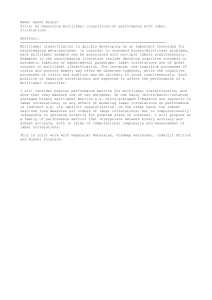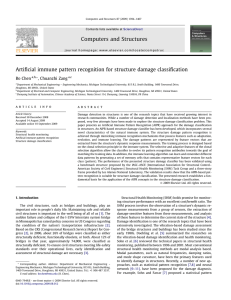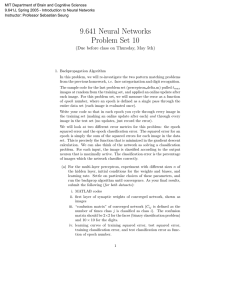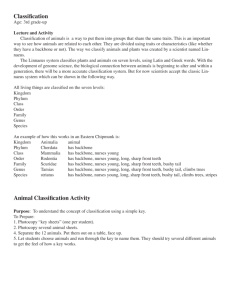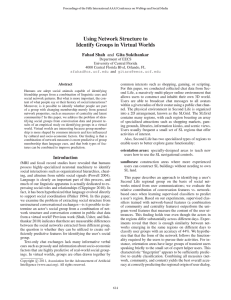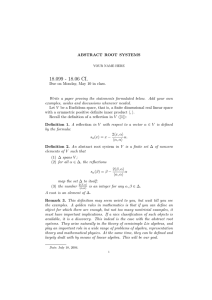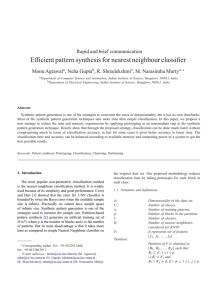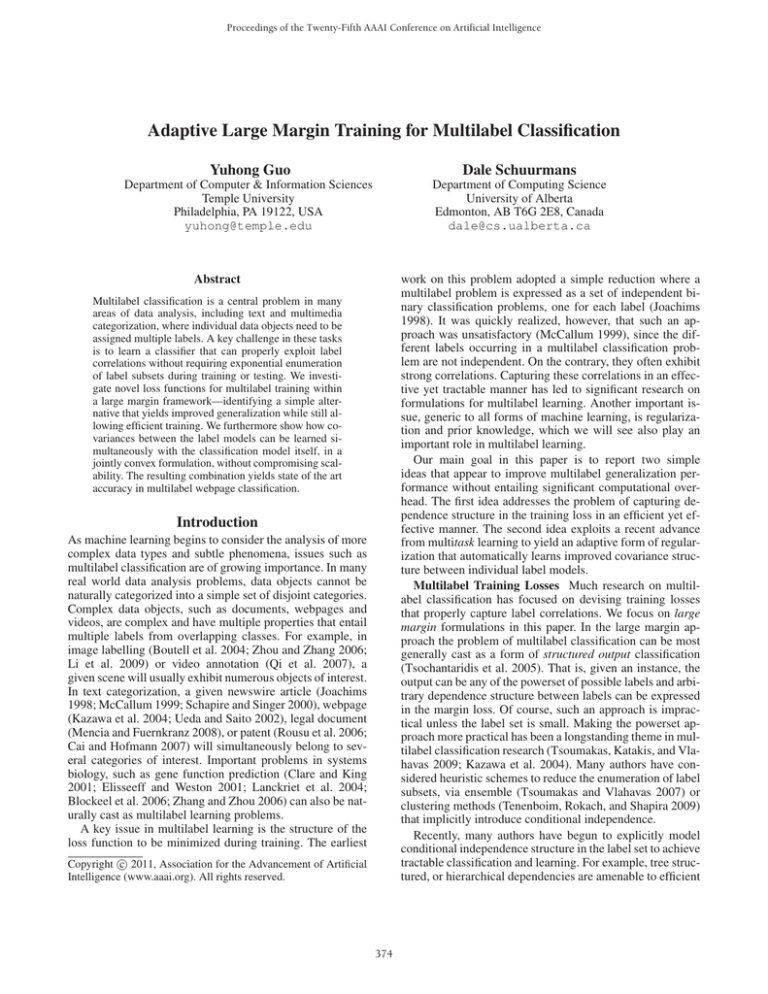
Proceedings of the Twenty-Fifth AAAI Conference on Artificial Intelligence
Adaptive Large Margin Training for Multilabel Classification
Yuhong Guo
Dale Schuurmans
Department of Computer & Information Sciences
Temple University
Philadelphia, PA 19122, USA
yuhong@temple.edu
Department of Computing Science
University of Alberta
Edmonton, AB T6G 2E8, Canada
dale@cs.ualberta.ca
work on this problem adopted a simple reduction where a
multilabel problem is expressed as a set of independent binary classification problems, one for each label (Joachims
1998). It was quickly realized, however, that such an approach was unsatisfactory (McCallum 1999), since the different labels occurring in a multilabel classification problem are not independent. On the contrary, they often exhibit
strong correlations. Capturing these correlations in an effective yet tractable manner has led to significant research on
formulations for multilabel learning. Another important issue, generic to all forms of machine learning, is regularization and prior knowledge, which we will see also play an
important role in multilabel learning.
Our main goal in this paper is to report two simple
ideas that appear to improve multilabel generalization performance without entailing significant computational overhead. The first idea addresses the problem of capturing dependence structure in the training loss in an efficient yet effective manner. The second idea exploits a recent advance
from multitask learning to yield an adaptive form of regularization that automatically learns improved covariance structure between individual label models.
Multilabel Training Losses Much research on multilabel classification has focused on devising training losses
that properly capture label correlations. We focus on large
margin formulations in this paper. In the large margin approach the problem of multilabel classification can be most
generally cast as a form of structured output classification
(Tsochantaridis et al. 2005). That is, given an instance, the
output can be any of the powerset of possible labels and arbitrary dependence structure between labels can be expressed
in the margin loss. Of course, such an approach is impractical unless the label set is small. Making the powerset approach more practical has been a longstanding theme in multilabel classification research (Tsoumakas, Katakis, and Vlahavas 2009; Kazawa et al. 2004). Many authors have considered heuristic schemes to reduce the enumeration of label
subsets, via ensemble (Tsoumakas and Vlahavas 2007) or
clustering methods (Tenenboim, Rokach, and Shapira 2009)
that implicitly introduce conditional independence.
Recently, many authors have begun to explicitly model
conditional independence structure in the label set to achieve
tractable classification and learning. For example, tree structured, or hierarchical dependencies are amenable to efficient
Abstract
Multilabel classification is a central problem in many
areas of data analysis, including text and multimedia
categorization, where individual data objects need to be
assigned multiple labels. A key challenge in these tasks
is to learn a classifier that can properly exploit label
correlations without requiring exponential enumeration
of label subsets during training or testing. We investigate novel loss functions for multilabel training within
a large margin framework—identifying a simple alternative that yields improved generalization while still allowing efficient training. We furthermore show how covariances between the label models can be learned simultaneously with the classification model itself, in a
jointly convex formulation, without compromising scalability. The resulting combination yields state of the art
accuracy in multilabel webpage classification.
Introduction
As machine learning begins to consider the analysis of more
complex data types and subtle phenomena, issues such as
multilabel classification are of growing importance. In many
real world data analysis problems, data objects cannot be
naturally categorized into a simple set of disjoint categories.
Complex data objects, such as documents, webpages and
videos, are complex and have multiple properties that entail
multiple labels from overlapping classes. For example, in
image labelling (Boutell et al. 2004; Zhou and Zhang 2006;
Li et al. 2009) or video annotation (Qi et al. 2007), a
given scene will usually exhibit numerous objects of interest.
In text categorization, a given newswire article (Joachims
1998; McCallum 1999; Schapire and Singer 2000), webpage
(Kazawa et al. 2004; Ueda and Saito 2002), legal document
(Mencia and Fuernkranz 2008), or patent (Rousu et al. 2006;
Cai and Hofmann 2007) will simultaneously belong to several categories of interest. Important problems in systems
biology, such as gene function prediction (Clare and King
2001; Elisseeff and Weston 2001; Lanckriet et al. 2004;
Blockeel et al. 2006; Zhang and Zhou 2006) can also be naturally cast as multilabel learning problems.
A key issue in multilabel learning is the structure of the
loss function to be minimized during training. The earliest
c 2011, Association for the Advancement of Artificial
Copyright Intelligence (www.aaai.org). All rights reserved.
374
Loss Functions for Multilabel Classification
dynamic programming, and several authors have investigated multilabel learning over label hierarchies (Rousu et al.
2006; Cai and Hofmann 2007). These approaches, however,
require that a label hierarchy be provided. Although it is possible to try to learn such a hierarchy as part of the training
process, such methods have remained heuristic.
By far the most popular approach to simplifying the dependence structure between labels, without eliminating dependence entirely, is to assume only pairwise dependence.
Many probabilistic approaches have adopted models that
express pairwise dependence over labels (Zhu et al. 2005;
Ghamrawi and McCallum 2005), but unfortunately these
generally lead to hard classification problems: a pairwise
field over labels for a given instance still generally entails
an intractable search to recover an optimal label set (although efficient algorithms can be found in some special
cases (Kang, Jin, and Sukthankar 2006)). A simpler version
of this idea has proved to be somewhat more practical: learn
a simple ranking function over labels by training on label
pairs (Elisseeff and Weston 2001; Schapire and Singer 2000;
Zhang and Zhou 2006; Fuernkranz et al. 2008).
In this paper, rather than consider a pairwise dependence
structure, we investigate a simpler notion of separation dependence. That is, rather than require “all-pairs” training of a
ranking function, we train a ranking function merely to separate the correct from incorrect labels for each instance. The
novel form of large margin loss we employ is a modification
of the topic-ranking loss of (Crammer and Singer 2003). We
show that this simpler dependence structure enables efficient
and exact classification in a multilabel setting. Surprisingly,
we find that the classification performance is generally superior to that of all-pairs training.
Regularization Independent of the training loss, regularization is always another key aspect of effective training. It has been observed in (Hariharan et al. 2010) that
prior knowledge about label covariances can be exploited
to achieve state of the art generalization performance, even
when using the simple independent binary loss. Others have
observed that estimating label covariances as a postprocessing step is also helpful (Boutell et al. 2004; Barutcuoglu,
Schapire, and Troyanskaya 2006). We prove that the prior
knowledge formulation of (Hariharan et al. 2010) is equivalent to introducing an inverse covariance matrix in the regularizer. Although such covariance information will not always be available, we show that an optimal label covariance
matrix can be learned simultaneously with the classification
model, by expressing the problem in a jointly convex form.
Importantly, the resulting training formulation does not entail significant computational overhead.
There are many other approaches to multilabel training that are beyond the scope of this paper. We are not
able to discuss the numerous works that have considered
nearest neighbor approaches (Zhang and Zhou 2005; 2007;
Jin, Wang, and Zhou 2009; Cheng and Huellermeier 2009),
or subspace learning approaches (Yu, Yu, and Tresp 2005;
Yan, Tesic, and Smith 2007; Park and Lee 2008; Zhang and
Zhou 2008; Hsu et al. 2009; Ji et al. 2010). (We note that the
approaches we investigate in this paper are directly compatible with subspace learning however.)
We assume a t × n matrix of input observations X and a
t × L matrix of boolean label indicators Y are provided,
where Yil = 1 when instance i has label l, and Yil = 0
otherwise. We will find it convenient to work with the ±1
label indicator matrix Z = 2Y −1, Y = (Z +1)/2, at times.
For simplicity, we will also assume a linear model for classification that uses an N dimensional feature map φ(·) over
input observations and is parameterized by an N × L weight
matrix W . (This will be reexpressed in a kernel representation later.) Given an input instance x, an L dimensional
response vector s(x) = φ(x) W is recovered using W , giving a “score” for each label. These scores will be compared
to a threshold to determine which labels are to be predicted.
We focus on large margin formulations of multilabel
training. Large margin training, as in all standard forms of
loss minimization, consists of minimizing a loss function
over the data subject to a regularizer. That is, given X and
Y , a generic training problem can be expressed as
(1)
min β2 W 2F + i (Yi: ; s(Xi: ))
W
where ·F denotes Frobenius norm, (·; ·) is a loss function
that is convex in its second argument, β > 0 is a regularization parameter that controls the magnitude of weights in W ,
and s(x) = φ(x) W is the parameterized score function.
Multilabel classification losses are typically contrasted
with multiclass and binary classification losses respectively.
For multiclass classification, we assume that any training label vector Yi: has only a single 1 entry, which we can indicate by a label li such that Yi: = 1li (a vector of all 0s except
for a 1 in the li th position). The standard large margin multiclass loss (Crammer and Singer 2001) is
max 1(l=li ) + sl (Xi: ) − sli (Xi: )
l
(2)
That is, we want to promote the score sli (Xi: ) of the correct
label li above the score sl (Xi: ) of any alternative label l for
l = li by a margin of 1.
In the binary classification case, we do not work with a
N × 2 model W but an N × 1 weight vector w, yielding a
score value that is a scalar not a vector. Here one also works
with a t × 1 vector of ±1 valued training labels z rather than
a t × 2 matrix Y . In this case, the standard SVM loss is
(1 − zi s(Xi: ))+
(3)
where (1−zi s(Xi: ))+ = max(0, 1−zi s(Xi: )).
The original large margin approach to multilabel classification (Joachims 1998) decomposed the training loss into a
sum over independent binary training losses for each label
(1 − Zil sl (Xi: ))+
(4)
l
an approach we refer to as independent binary training.
Given a test example x, its labelling is determined by zl∗ =
arg maxzl ∈±1 zl sl (x). Most work since has expressed dissatisfaction with treating the labels as independent, and investigated losses that account for correlations among labels.
As mentioned in the introduction, the most general approach to multilabel classification in the large margin setting
375
The choice of reference s0 can be left adaptive or fixed to
some reference value, such as s0 (Xi: ) = 0. Unfortunately,
it can be shown, using the transformation (Z−1)/2 = Y and
s0 (Xi: ) = 0 the loss (8) reduces to a form of independent
binary training.2 Consequently, we have not found this loss
to be effective in practice.
However, an interesting and effective new loss is obtained
by applying the calibration idea to (7). In particular, we proposed the following calibrated separation ranking loss for
multilabel classification
is structured output prediction (Tsochantaridis et al. 2005)
that can account for arbitrary label interactions:
(yl − Yil )sl (Xi: )
(5)
max Δ(y; Yi: ) +
y∈{0,1}L
l
for some misclassification loss Δ(y; Yi: ). Note that as given,
(5) is not easy to compute since it involves a search over
2L alternative labellings. Nevertheless, this loss can express
arbitrary relationships between the behavior of
individual
labels. Note that if one chooses Δ(y; Yi: ) =
l 1(yl =Yil )
then (5) becomes equal to (4), hence structured output training reduces to independent binary training.1 However, if instead one chooses Δ(y; Yi: ) = 1(y=Yi: ) , yielding a loss
of 0 only if the two vectors are identical across all labels, then a large margin form of “label powerset” training is achieved (Tsoumakas, Katakis, and Vlahavas 2009;
Tsoumakas and Katakis 2007).
The best known attempt to capture label correlations
while avoiding exponential enumeration is the pairwise
ranking loss introduced by (Elisseeff and Weston 2001)
1 1 (1 + sl̄ (Xi: ) − sl (Xi: ))+
(6)
|Yi: | |Ȳi: |
l∈Y
i:
max(1+s0 (Xi: )−sl (Xi: ))+ +max(1+sl̄ (Xi: )−s0 (Xi: ))+ (9)
l∈Yi:
Calibrated Separation Ranking: Dual Form
Combining (1) with (9) yields the regularized loss minimization problem we consider for multilabel classification
training. Let Φi: = φ(Xi: ), so that the feature representations of the training instances are expressed in a t × N
matrix Φ. Given that the loss (9) is piecewise linear and convex, this problem can be equivalently expressed by a convex
quadratic program.
l̄∈Ȳi:
where |Yi: | is the number of 1s in Yi: and Ȳi: = 1 − Yi: . Although (6) clearly accounts for pairwise correlations during
training, classification is difficult with this approach because
given a test example x the resulting vector of scores s(x) can
only be interpreted as a ranking over labels; that is, the cutoff
threshold for asserting the presence of a label is not determined by this method. (Elisseeff and Weston (2001) explore
a post-hoc heuristic for determining the threshold.) Thus,
this approach is usually referred to as a multilabel ranking
rather than a multilabel classification method.
A variant of this loss is the separation ranking loss
max max(1 + sl̄ (Xi: ) − sl (Xi: ))+
l∈Yi: l̄∈Ȳi:
l̄∈Ȳi:
Given a test example x its classification is determined by
yl∗ = arg maxyl ∈{0,1} yl (sl (x) − s0 (x)). To the best of our
knowledge, the loss (9) has not been previously investigated
in the literature, yet we find that it gives superior results to
the standard margin losses in our experiments below.
min β2 (W 2F + u22 ) + 1 ξ + 1 η
W,u
subject to
ξi ≥ 1 + Φi: u − Φi: W:l for l ∈ Yi: , ∀i
ηi ≥ 1 − Φi: u + Φi: W:l̄ for ¯l ∈ Ȳi: , ∀i
ξ ≥ 0, η ≥ 0
(10)
where 1 denotes a vector of all 1s. Note, if we wish to enforce a constant dummy score s0 so that s0 (Xi: ) = 0 we can
fix u = 0 in (10).
The dual of this quadratic program is
(7)
max 1 (M + N )1 −
M,N
1
2β tr((M
− N ) K(M − N )Θ)
M ≥ 0, M 1 ≤ 1, Mil̄ = 0 for ¯l ∈ Ȳi:
N ≥ 0, N 1 ≤ 1, Nil̄ = 0 for l ∈ Yi:
proposed by (Crammer and Singer 2003). As for the pairwise ranking loss the classification threshold is not determined, and again, the resulting approach is considered a
multilabel ranking rather than classification method.
Recently, Fuernkranz et al. (2008) observed that the main
weakness with ranking losses, such as those above, is that
they are “uncalibrated”. In these cases, effective multilabel
classification can be recovered by introducing a reference label against which all other labels are compared. Effectively,
one introduces a new dummy label l0 and uses the corresponding dummy score s0 (Xi: ) as a reference of comparison between the relevant and irrelevant labels. For example,
using this idea (6) can be reformulated as
1
l∈Yi: (1 + s0 (Xi: ) − sl (Xi: ))+
|Yi: |
+ |Ȳ1i: | l̄∈Ȳi: (1 + sl̄ (Xi: ) − s0 (Xi: ))+
(8)
s.t.
(11)
where K = ΦΦ , M and N are both t × L dual parameter
matrices, and Θ is a constant matrix Θ = I + 11 . Thus the
problem is now expressed entirely with respect to a kernel.
In our experiments below, we use a more compact version
of this quadratic program, using the fact that M and N are
nonzero on complementary entries. That is, by letting A =
M − N one obtains the more concise form
max tr(A Z) −
A
1
2β tr(A KAΘ)
subject to
A ◦ Y ≥ 0, diag(A Y ) ≤ 1
A ◦ (Y − 1) ≥ 0, diag(A (Y − 1)) ≤ 1
(12)
where ◦ denotes componentwise multiplication, and diag denotes the main diagonal vector of a square matrix.
In
particular, by using s0 (Xi: )1 =0, (8) becomes equal to
(1 − Zil sl (Xi: ))+ + |Ȳ | l̄∈Ȳ (1 − Zil̄ sl̄ (Xi: ))+ ,
l∈Yi:
i:
i:
which is essentially independent binary with some normalization.
1
Proved using
the substitution Yi: = (Zi:−1)/2 and y = (z−1)/2
and
noting that l maxzl ∈±1 1(zl=Zil ) + (zl − Zil )sl (Xi: )/2 =
(1−Zil sl (Xi: ))+ .
l
2
1
|Yi: |
376
where R = P P . Thus, P influences the training problem
by altering the regularization with respect to the inverse covariance R−1 = (P P )−1 . This is precisely the form of
covariance regularization used in current multitask learning
formulations (Zhang and Yeung 2010) to enforce task relatedness; see also (Argyriou et al. 2008). So in this way (Hariharan et al. 2010) are implicitly imposing the same form of
regularization on multilabel learning. One advantage of the
alternative formulation (16) is that it is jointly convex in both
the model parameters U and u and in the covariance matrix
R (Boyd and Vandenberghe 2004).
This allows optimal training of the covariance matrix
simultaneously with the classification model; yielding an
adaptive form of training that appears to be novel in the
multilabel learning literature. In particular, we can reexpress
the previous quadratic programming formulation (12) as a
convex-concave program that does not have local minima.
Algorithmic Approach
Unfortunately, a drawback with (12) is still that it requires
space quadratic in the number of training instances t simply
to store the kernel matrix K. This is not practical in a real
multilabel learning scenario, since multilabel classification
problems tend to be large (Hariharan et al. 2010; Lewis et
al. 2004). To avoid the onerous space requirements of (12)
we formulate a scalable approach for tackling the problem
in the spirit of (Hariharan et al. 2010; Fan et al. 2008).
Note that the constraints in (12) decompose over training
examples and labels. This allows many different strategies
for incrementally solving the problem by tackling nearly independent components of A. Note that the entries of A corresponding to different training instances and labels are only
coupled in the quadratic objective
1
tr(A KAΘ)
(13)
f (A) = tr(A Z) − 2β
We have found it effective to update rows of A across labels,
which still leads to an efficient update. Consider an update
to row Ai: , which can be expressed as A ← A+1i (a−a0 ) ;
thus we are replacing a0 = Ai: with a new row a . Consider
the effect of this update on the objective
f (A + 1i (a − a0 ) ) = Zi: a − β1 a ΘA K:i + β1 a Θa0 Kii
1 − 2β
a ΘaKii + const
min max tr(A Z) −
R
(14)
Adaptive Regularization: Label Covariance
=
i
+ u u) +
+ α2 R − I2F
R 0, A ◦ Y ≥ 0, diag(A Y ) ≤ 1
A ◦ (Y − 1) ≥ 0, diag(A (Y − 1)) ≤ 1
s.t.
(17)
Experimental Results
To evaluate the proposed loss and regularization scheme, we
conducted experiments on multi-topic web page classification (Ueda and Saito 2002). The data consists of web pages
collected from the yahoo.com domain. We preprocessed the
data by first removing the largest class label (which covered
more than 50% of the instances) and removing class labels
that had fewer than 200 instances. We also removed any instances that had no labels or every label. For the instance feature representation, we removed any features that appeared
in fewer than 5 instances, and converted the remaining integer features into a standard tf-idf encoding. The statistics of
the preprocessed data sets are summarized in Table 2.
We compared two versions of our method, CSRL (for calibrated separation ranking loss) using an identity covariance matrix, and CSRL+R, which added the convex covariance learning scheme introduced above. We compared
our techniques to three other baseline large margin methods for multi-label classification: (1) the standard independent binary SVM, which trains a separate binary classifier
The work in (Hariharan et al. 2010) provides an interesting extension to the standard independent binary approach,
where an invertible L × L matrix P is introduced to express prior knowledge about the covariance structure of the
linear models learned for each label. Despite minimizing
a loss as simple as the independent binary loss, Hariharan et al. (2010) observe notable generalization improvements simply by incorporating prior knowledge about the
covariance structure. In particular, the score function s(x)
is modified to take P into account: sP (x) = φ(x) W P .
In this way, the response vector over labels, given x, takes
into account prior covariance structure stipulated by P . To
understand the effect of P more clearly, observe that
(Yi: ; φ(Xi: )W P )
(15)
min β2 (W 2F + u22 ) +
min β2 (tr(U R−1 U )
U,u
1
2β tr(A KAΓRΓ )
where Γ is a constant matrix Γ = [I, −1] such that ΓΓ = Θ.
Note that the R − I2F term regularizes the learned covariance matrix, keeping it proximal to the identity matrix to
avoid overfitting, while still allowing it to reduce the training loss of the multilabel classification model.
This form of covariance learning can be trivially added
to the scalable computational procedure outlined previously.
In our implementation, we alternate between updating A in
a complete pass over the data, then after each pass minimizing over R optimally given A by the closed form update
1
Γ A KAΓ which can be computed in linear
R ← I + 2αβ
space. Surprisingly, we find that learning R accelerates the
convergence of the previous update procedure for A, and we
witness both run time and generalization improvements in
our experiments below consequently.
Note that the update only requires computation of Ki: for a
single row in K, hence the cost is only linear in t for each
update. Also, the update to Aj: does not affect the update for
another row Ai: except through the term a ΘA K:i . Thus,
all one needs to do is maintain a t × L matrix C = KAΘ,
which can be updated locally after an update to Ai: by C ←
C + K:i (a − a0 ) Θ. Otherwise, the updates are independent.
There are many strategies to choose which rows to update
and, when selected, what value to update to. We have found
it effective simply to visit the training instances in a random order, and locally minimize f (A) with respect to row
Ai: under the local constraints in (12). This computational
approach allows us to solve the quadratic program for large
problems in linear space.
W,u
A
(Yi: ; φ(Xi: )U ) (16)
i
377
head over standard training. Experimental results indicate
that both the alternative loss function and adaptive regularization scheme yield improved generalization performance
in multilabel classification.
Table 1: Training time of the comparison methods (seconds).
Arts
Computers
Education
Entertain.
Health
Recreation
Reference
Science
Social
Society
CSRL CSRL-R
1195.0
701.9
1592.2
687.6
718.8
544.3
1020.0
497.4
1196.2
686.9
1369.0
1082.8
1097.0
660.3
703.6
416.2
796.8
505.4
1197.7
546.4
References
Argyriou, A., Evgeniou, T. and Pontil, M. 2008. Convex multi-task
feature learning. Machine Learning 73(3):243–272.
Barutcuoglu, Z.; Schapire, R.; and Troyanskaya, O. 2006. Hierarchical multi-label prediction of gene function. Bioinformatics
22:880–836.
Blockeel, H.; Schietgat, L.; Struyf, J.; Dzeroski, S.; and Clare, A.
2006. Decision trees for hierarchical multilabel classification: A
case study in functional genomics. In Proceedings PKDD, 18–29.
Boutell, M.; Luo, J.; Shen, X.; and Brown, C. 2004. Learning
multi-label scene classiffication. Patt. Recogn. 37(9):1757–1771.
Boyd, S., and Vandenberghe, L. 2004. Convex Optimization. Cambridge U. Press.
Cai, L., and Hofmann, T. 2007. Exploiting known taxonomies in
learning overlapping concepts. In Proceedings IJCAI, 714–719.
Cheng, W., and Huellermeier, E. 2009. Combining instance-based
learning and logistic regression for multilabel classification. In
Proceedings ECML-PKDD, 28–38.
Clare, A., and King, R. 2001. Knowledge discovery in multi-label
phenotype data. In Proceedings PKDD, 42–53.
Crammer, K., and Singer, Y. 2001. On the algorithmic implementation of multiclass kernel-based vector machines. JMLR 265–292.
Crammer, K., and Singer, Y. 2003. A family of additive online
algorithms for category ranking. JMLR 3:1025–1058.
Elisseeff, A., and Weston, J. 2001. A kernel method for multilabelled classification. In Proceedings NIPS.
Fan, R.; Hsieh, K. C. C.; Wang, X.; and Lin, C. 2008. LIBLINEAR:
A library for large linear classification. JMLR 9:1871–1874.
Fuernkranz, J.; Huellermeier, E.; Mencia, E.; and Brinker, K. 2008.
Multilabel classification via calibrated label ranking. Machine
Learning 73(2).
Ghamrawi, N., and McCallum, A. 2005. Collective multi-label
classification. In Proceedings CIKM.
Hariharan, B.; Zelnik-Manor, L.; Vishwanathan, S.; and Varma, M.
2010. Large scale max-margin multi-label classification with priors. In Proceedings ICML.
Hsu, D.; Kakade, S.; Langford, J.; and Zhang, T. 2009. Multi-label
prediction via compressed sensing. In Proceedings NIPS.
Ji, S.; Tang, L.; Yu, S.; and Ye, J. 2010. A shared-subspace learning framework for multi-label classification. ACM Transactions on
Knowledge Discovery in Data 4(2):1–29.
Jin, R.; Wang, S.; and Zhou, Z. 2009. Learning a distance metric
from multi-instance multi-label data. In Proc. CVPR, 896–902.
Joachims, T. 1998. Text categorization with support vector machines: learn with many relevant features. In Proceedings ECML.
Kang, F.; Jin, R.; and Sukthankar, R. 2006. Correlated label propagation with application to multi-label learning. In Proceedings
CVPR, 1719–1726.
Kazawa, H.; Izumitani, T.; Taira, H.; and Maeda, E. 2004. Maximal
margin labeling for multi-topic text categorization. In Proc. NIPS.
Lanckriet, G.; Deng, M.; Cristianini, N.; Jordan, M.; and Noble,
W. 2004. Kernel-based data fusion and its application to protein
function prediction in yeast. In Proc. Pacific Sympo. on Biocomput.
for each label; (2) the pairwise ranking loss SVM proposed
in (Elisseeff and Weston 2001), which first trains a large
margin ranking model and then learns the threshold of the
multilabel predications using a least-square method; and (3)
the large scale max-margin multi-label classification method
(M3L) proposed in (Hariharan et al. 2010), which takes prior
knowledge about the label correlations into account. In all
these experiments, we simply set the regularization parameters β = 1 and α = 10 respectively. The performance of
each method is evaluated using three measures: exact match
ratio, macro-F1, and micro-F1 (Tang, Rajan, and Narayanan
2009).
We randomly selected 800 instances from each data set
for training, and used the remaining data points for testing.
This process is repeated five times to generate five random
training/test partitions. The average performance and standard deviations of the 5 methods for each of the three evaluation measures is reported in Table 3.
One can see from these results that the novel loss employed by CSRL provides a significant improvement in generalization accuracy over the baseline methods, in all of
the data sets considered. Notably, the inclusion of covariance learning in CSRL+R actually improves the convergence properties of the iterative training algorithm for solving the convex (convex-concave) program; see Table 1.
Conclusion
We have investigated new large margin loss functions and
new adaptive regularization schemes for multilabel classification learning. The new loss we investigate, calibrated separation ranking, effectively takes into account label correlations without reducing to independent binary classification
under calibration (unlike the pairwise ranking (Elisseeff and
Weston 2001) under calibration (Fuernkranz et al. 2008)).
We observe significant improvements over baseline training losses, independent binary and pairwise ranking. Furthermore, we show how the method for incorporating prior
knowledge proposed by (Hariharan et al. 2010) is equivalent to an inverse covariance regularization of the multilabel model. We exploit this observation to formulate a convex training principle for adapting both the label covariance (regularization) matrix and the classification model, in
an efficient joint training scheme that entails minimal over-
378
Table 2: Statistics of the multi-label data sets: k–the number of classes, d–the number of features, T –the number of instances.
Params
Arts Computers Education Entertain. Health Recreation Reference Science Social Society
k
15
19
11
13
13
14
11
15
11
18
12011
14026
11320
16506 13909
15007
8341
11942 13651
22973
d
3298
3716
3920
3512
4425
3881
1132
1865
2426
5824
T
Table 3: Summary of the performance (%) for the compared methods in terms of exact match ratio (top section), macro F1
(middle section), and micro F1 (bottom section).
Methods
SVM
RankPair
M3L
CSRL
CSRL+R
SVM
RankPair
M3L
CSRL
CSRL+R
SVM
RankPair
M3L
CSRL
CSRL+R
Arts Computers Education Entertain.
Health Recreation Reference Science
Social Society
0±0.0
0±0.0 0.1±0.1 3.8±0.1
0±0.0
0±0.0 13.8±0.2
0±0.0
0±0.0 2.2±0.0
3.4±0.1
0.3±0.1 1.9±0.4 3.6±2.5 1.1±0.5
0.3±0.2 10.7±2.7 0.6±0.2 3.8±1.5 1.1±0.5
2.6±0.5 12.1±0.3 13.2±0.6 4.7±2.4 7.4±1.6
0.0±0.0 13.9±0.5 8.4±1.6 16.5±1.0 2.2±0.0
8.0±0.3 12.4±0.3 17.9±0.3 16.3±0.5 17.1±0.1 11.4±0.6 16.2±0.6 10.8±0.3 17.9±0.6 2.2±0.1
8.2±0.3 13.5±0.3 18.0±0.4 17.3±0.4 17.9±0.1 11.6±0.6 16.4±0.8 11.2±0.4 18.1±0.6 2.2±0.1
5.5±0.0
4.0±0.0 8.1±0.1 12.5±0.1
0±0.0
6.6±0.0 16.0±0.0 5.4±0.0 8.2±0.0 8.7±0.0
10.2±1.8
6.1±0.2 23.9±1.4 23.2±0.5 13.8±1.5 13.7±0.3 16.0±1.9 11.2±1.9 15.9±1.2 11.4±0.8
9.6±0.2
6.8±0.6 26.0±0.5 13.0±0.1 19.5±1.0
6.6±0.0 16.5±0.2 14.2±1.2 26.7±0.8 8.7±0.0
41.4±0.2 40.7±0.3 49.5±0.3 57.5±0.5 55.3±0.2 45.2±0.5 47.8±0.4 46.4±0.5 49.5±0.5 37.2±0.1
41.5±0.2 40.7±0.3 49.2±0.3 57.4±0.5 55.3±0.3 45.1±0.5 47.9±0.4 46.3±0.5 49.3±0.5 37.3±0.1
34.5±0.1 31.6±0.1 39.2±0.1 53.2±0.1
0±0.0 43.9±0.1 67.4±0.3 34.4±0.3 46.7±0.1 48.3±0.1
42.1±0.1 33.7±0.3 52.4±1.3 61.1±0.3 39.2±5.3 50.7±1.2 61.0±5.8 40.3±2.2 53.7±1.4 45.9±1.4
42.1±0.4 36.5±1.1 54.9±0.4 53.6±0.1 47.7±0.4 44.0±0.1 67.5±0.3 47.1±1.1 62.7±0.5 48.3±0.1
52.3±0.1 50.0±0.1 64.1±0.2 68.3±0.2 61.7±0.3 60.1±0.3 68.7±0.1 56.9±0.3 66.1±0.2 50.7±0.1
52.3±0.1 50.2±0.2 64.0±0.2 68.3±0.2 61.8±0.3 60.2±0.3 68.8±0.1 57.0±0.3 66.1±0.2 50.8±0.1
Tsoumakas, G., and Katakis, I. 2007. Multi-label classification an
overview. International Journal of Data Warehousing and Mining.
Tsoumakas, G., and Vlahavas, I. 2007. Random k-labelsets: An
ensemble method for multilabel classification. In Proc. ECML.
Tsoumakas, G.; Katakis, I.; and Vlahavas, I. 2009. Mining multilabel data. In Data Mining and Knowledge Discovery Handbook,
2nd edition. Springer.
Ueda, N., and Saito, K. 2002. Parametric mixture models for multilabeled text. In Proceedings NIPS 15, 721–728.
Yan, R.; Tesic, J.; and Smith, J. 2007. Model-shared subspace
boosting for multi-label classification. In Proceedings SIGKDD.
Yu, K.; Yu, S.; and Tresp, V. 2005. Multi-label informed latent
semantic indexing. In Proceedings SIGIR.
Zhang, Y., and Yeung, D. 2010. A convex formulation for learning
task relationships in multi-task learning. In Proceedings UAI.
Zhang, M., and Zhou, Z. 2005. A k-nearest neighbor based algorithm for multi-label classification. In IEEE International Conference on Granular Computing, 718–721.
Zhang, M., and Zhou, Z. 2006. Multilabel neural networks with
applications to functional genomics and text categorization. IEEE
Trans. Knowledge and Data Eng. 18(10):1338–1351.
Zhang, M., and Zhou, Z. 2007. Multi-label learning by instance
differentiation. In Proceedings AAAI, 669–674.
Zhang, M., and Zhou, Z. 2008. Multi-label dimensionality reduction via dependency maximization. In Proc. AAAI, 1503–1505.
Zhou, Z., and Zhang, M. 2006. Multi-instance multi-label learning
with application to scene classification. In Proceedings NIPS 19.
Zhu, S.; Ji, X.; Xu, W.; and Gong., Y. 2005. Multi-labelled classification using maximum entropy method. In Proceedings SIGIR.
Lewis, D.; Yang, Y.; Rose, T.; and Li, F. 2004. RCV1: A
new benchmark collection for text categorization research. JMLR
5:361–397.
Li, Y.; Ji, S.; Ye, J.; Kumar, S.; and Zhou, Z. 2009. Drosophila
gene expression pattern annotation through multi-instance multilabel learning. In Proceedings IJCAI, 1445–1450.
McCallum, A. 1999. Multi-label text classification with a mixture
model trained by em. In AAAI Workshop on Text Learning.
Mencia, E., and Fuernkranz, J. 2008. Efficient pairwise multilabel classification for large scale problems in the legal domain. In
Proceedings PKDD.
Park, C., and Lee, M. 2008. On applying linear discriminant
analysis for multi-labeled problems. Pattern Recognition Letters
29:878–887.
Qi, G.; Hua, X.; Rui, Y.; Tang, J.; Mei, T.; and Zhang, H. 2007.
Correlative multi-label video annotation. In Proc. Multimedia.
Rousu, J.; Saunders, C.; Szedmak, S.; and Shawe-Taylor, J.
2006. Kernel-based learning of hierarchical multilabel classification models. JMLR 7:1601–1626.
Schapire, R., and Singer, Y. 2000. Boostexter: A boosting-based
system for text categorization. Machine Learning 39:135–168.
Tang, L.; Rajan, S.; and Narayanan, V. 2009. Large scale multilabel classification via metalabeler. In Proceedings WWW.
Tenenboim, L.; Rokach, L.; and Shapira, B. 2009. Multi-label
classification by analyzing labels dependencies. In International
Workshop on Learning from Multi-Label Data.
Tsochantaridis, I.; Hofmann, T.; Joachims, T.; and Altun, Y. 2005.
Large margin methods for structured and interdependent output
variables. JMLR 6:1453–1484.
379

